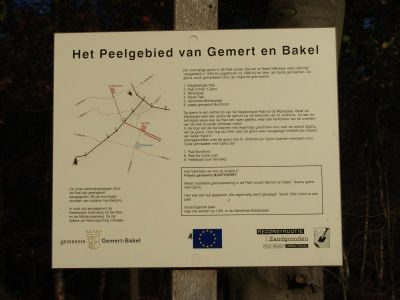Grenspaal Bunthorst Paal (Kuil)
Contents
1 The Bunthorste Pile
1.1 The Bunthorste Pole or pit
1.2 The pit is lost
1.3 Today
Gemert-Oploo border. This boundary post was erected at the restoration of all boundary posts in the peel De Bunthorste Paal or pit.
On the Gemert-Oploo border is the Bunthorst, now a varied mixture of forest and heathland. The boundary marker there did not consist of a boundary post, but instead a pit was dug. This was a cheaper method than erecting a post but in the damp soil of the Peel such a pit could also quickly disappear, as the story below shows.
The pit is lost
On September 6, 1621, the notables of Box…
Contents
1 The Bunthorste Pile
1.1 The Bunthorste Pole or pit
1.2 The pit is lost
1.3 Today
Gemert-Oploo border. This boundary post was erected at the restoration of all boundary posts in the peel De Bunthorste Paal or pit.
On the Gemert-Oploo border is the Bunthorst, now a varied mixture of forest and heathland. The boundary marker there did not consist of a boundary post, but instead a pit was dug. This was a cheaper method than erecting a post but in the damp soil of the Peel such a pit could also quickly disappear, as the story below shows.
The pit is lost
On September 6, 1621, the notables of Boxmeer, together with a number of residents of that place, went to the outermost boundary post in the Peel and arrived there on a mountain called the Bunthorst, the separation from the territory of Gemert. Reason for this walk: some Gemert people had crossed the border a few times and every time they caught sight of the Boxmeer archers, they stretched out and went "into the flight. (The Gemerten people had allowed their animals to graze on Boxmeer's land and also cut peat there, both of which were strictly forbidden. Archers were those who illegally drove animals in their community to the nearest inn where the owner could pick them up for a fee). Together with representatives from Gemert, attempts were made to clarify the exact location of the border between the two. 'We met,' said the gentlemen from Boxmeer, 'those from Gemert at the Bunthorst.' They defended that they had the whole bergske for them alone. But before us the innkeeper of St. Thunis - over 70 years of age - pronounced in a hellish voice that Jan Hendricx the elder, in his lifetime already over 90 years of age,
had always said to him that Jan Schatz, his predecessor as right-hand man, always said that the rainwater that fell on the bergske de Bunthorst formed the separation: what ran off to the Gemert side was from Gemert and what ran off to the Meersche side was from Boxmeer. A number of witnesses subsequently confirmed the story of the innkeeper from St. Anthonis.
Gemert-Oploo border. This is how the former boundaries were
The commander of Gemert responded by bringing forward Aert de Lodder: "Lodder, Lodder, ghij werdt me altijt veel tho seggen van die palen, spreeckt nu." Alas, Aert could not point to any posts other than those on the Bunthorst, despite the fact that he wandered around for a long time. But the commander still had two, albeit somewhat rusty irons in the fire. Two very old, stiff men from Gemert, who had been sitting on a wagon for a long time in search of Aert de Lodder and who had become even more stiff because of all the bumping and jolting through the Peel, were asked by the commander to get off the wagon and point out the right boundary post. Only one of the two could comply; the other old man had become too stiff. While Aert de Lodder searched in ever-widening circles around the bergske for (alleged) boundary posts and the assembled public straightened their backs and leaned on the other leg, the old Gîmmert manneke scurried around at his leisure, stopped for a long time at this or that tree trunk and finally declared that he could not find a post.
The commander, no doubt disappointed in the performance of his witnesses, therefore agreed to the proposal of the Boxmeer village officials: the area between the Bunthorst and the three ditches, dug by those of St. Anthonis in wartime, was given a separate status. Gemert animals were not to be fenced in, but Gemert people were not allowed to cut peat there either. If they did, they would also be shelled on a high breuck! After which the parties, in the pleasant knowledge of having maintained good neighborly relations in the right way, accepted the long journey back to their villages.
The agreement held up just fine. It wasn't until nearly a century later, in 1714, that Gemert deemed the time ripe for another inspection of the limit in the Peel between Gemert and Boxmeer. The Gemert aldermen 'stretched the banke' in the Peel at the place called the Meer, and the ditch between the lordships of Boxmeer and Gemert was renewed: "We have gone to the Bunthorst past the koeij (= sheep pens), belonging to Gemert, and from there to the Bunthorstse weeteringe, where the cuijle there has also been renewed.

